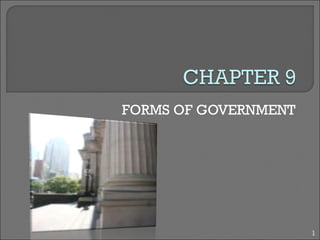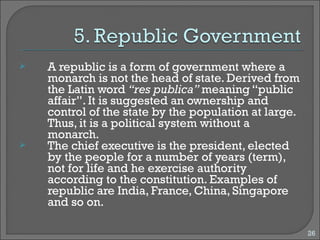C9 government
- 2. ï Form of government is a system by which a state is governed. There are various forms of state and government and in practice; it is possible to combine multiple forms. 2
- 3. ï The term âgovernmentâ is often used to refer to the body of people and institutions that make and enforce laws for a society (Abdul Rashid & Syed Serajul, 2005). ï Though the governments may differ from one society to the other, they all share certain characteristics that make them different from all other forms of human organizations. 3
- 4. ï Aristotleâs classification of governments (source: Abdul Rashid & Syed Serajul, 2005) RULE BY Form One Few Many Good Monarchy Aristocracy Polity Bad Tyranny Oligarchy Democracy 4
- 5. 5
- 6. ï The presidential system is where the legislature and the executive are two distinct departments of government. In other word, it is a system with separate election of an executive president. ï It is a democratic system. ï Legislature and executive are elected independently of each other. ï eg. United States of America. 6
- 7. ï The President will form his own âcabinetâ made up of ministers. ï The members of the cabinet are not members of the legislature. ï The president is independent of the legislature. 7
- 8. 1. It retains a representative character anh his position does not depend on the legislature. 2. Unity of control âfast decision and well organized policy. 3. Appointment of experts . 4. Able to concentrate on administrative work alone. 5. Separation of powers âthere exist a greater sense of stability. 8
- 9. 1. A time consuming system âdelay in term of agreement. 2. Lack of initiative between executive and legislature. 3. Autocratic, irresponsible and dangerous system. 9
- 10. ï It is a system with the election of parliament only, which in turn elects a prime minister. ï Executive and legislative branches is unified and coordinate under the control of the same persons. ï Clear distinction between the head of the state and the head of the government. ï e.g. Britain, Malaysia and Singapore. 10
- 11. 1. Ensures harmonious cooperation between the executives and legislative branches of government. 2. Recognizes the ultimate sovereignty of the people. 3. A government by criticism. 4. Flexibility and elasticity. 11
- 12. 1. Violates the theory of separation of powers. 2. The system is unstable âit remains in office only as long as it can retain parliamentary majority. 3. Majority and opposition. 4. Inefficient system. 5. Growing size of the cabinet. 6. Monopolize by majority party. 12
- 13. ï âFederationâ comes from the Latin word âfoedusâ meaning âtreatyâ or âagreementâ. It is a treaty or agreement between independent states and the new unit of government. A new state is created when sovereign states surrender their sovereignty and agree to become its components parts. 13
- 14. ï Therefore a federation is a state comprised of a number of self-government regions (states) united by a central (federal) government. ï In a federal, the sovereign political power is exercised at two levels namely the national and regional level. ï For example, the Federal Constitution of Malaysia (Ninth Schedule) contains the Federal List, State List and Concurrent List. 14
- 15. ïķ Reasons for starting a federal union (Roskin and Medeiros): a) National security : small and weak states cannot defend themselves against powerful aggressors. b) Economic purpose : create a wide market without worrying about tariff barriers. For example, the European Union (EU). c) National unity : federalism is often the only way to protect national unity as it allows the different states to maintain their own cultures. 15
- 16. ï e.g. Malaysia, United States of America (a confederation where the central government is considerably weaker than the state government) and Australia. 16
- 17. ïķ Basic features of a Federation: 1) It allows the federating units to preserve their identity; retain their independent jurisdiction, except in matters of national interest. 2) The states willingly lose sovereignty to form a federation; the result is a new sovereign state. 3) Mechanism of a federal is that it has two level of government namely the national or central government and regional or state government. 4) Powers of government are divided and distributed into central and state government. 5) Federation is made deliberately and since powers are divided and distributed, a written constitution is needed. It involves rigid constitution so that the central and regional government cannot take away the otherâs power.The process of amending constitution is in the constitution itself. 6) Federation is a permanent union. 17
- 18. ï Important elements of federal government: 1. A written constitution 2. A rigid constitution 3. Presence of Federal Court 18
- 19. 1. Federation is a combination of unity and diversity. 2. To allow larger scope for local developments and administrative experimentation. 3. Ensures political liberty of the people. 19
- 20. 1. Contest between government. 2. Rigid constitution. 3. Difficulty of coordination. 4. Financially expensive. 20
- 21. ï In a unitary, there is only one integrated system of government and the supreme power belongs to the central government. In other words, the government structure consists only of central government (supreme power) and local government (delegated power). ï e.g. Britain 21
- 22. ïķ Characteristics or features of a unitary government : 1) Judiciary System : there is only one court system; the high court. Judicial officers are appointed by the national government. 2) Law Making : only the central government has the absolute rights and powers in the administration; therefore conflict of opinions will not occur. 3) Sub-divisions : there is no power (or very limited power) for the local government. They just carry out duties based on the order or directive of the central government. 22
- 23. ï Therefore a unitary state is a state in which no other governmental body but the central government has any areas of policy that are exclusively under its control. 23
- 24. 1. Effective and flexible â the system allows modification and adjustment to the organization. 2. Unity âall powers of government are concentrated in the hands of a single set of authorities. 3. Speed â speed of decision and firmness of action. 4. Minimize conflict â no overlapping of jurisdiction. 24
- 25. 1. Work overloaded â the central government need to manage both national and international problems. 2. Unsuitable for large areas and diverse population. 25
- 26. ï A republic is a form of government where a monarch is not the head of state. Derived from the Latin word âres publicaâ meaning âpublic affairâ. It is suggested an ownership and control of the state by the population at large. Thus, it is a political system without a monarch. ï The chief executive is the president, elected by the people for a number of years (term), not for life and he exercise authority according to the constitution. Examples of republic are India, France, China, Singapore and so on. 26
- 27. ï Basically it means hereditary rule by one person. Monarchy comes from the Greek word âmonos arkheinâ meaning âone rulerâ is a form of government that has a monarch as Head of State/country. ï The term monarchy is also used to refer to the people and institutions that make up the royal establishment, or to the realm or land in which the monarchy functions. 27
- 28. ï There are two types of monarchy; 1. Absolute monarchy 2. Limited/constitutional monarchy 28
- 29. 1. Absolute monarchy ïķ Absolute monarchy is where the ruler has the power to rule their country and citizens freely with no laws telling the monarchy what to do. ïķ The source of all political authority is in a supreme ruler. 29
- 30. ï An absolute monarch has total power over its people and land. ï There are only a few absolute monarchies in the modern world such as Swaziland and Brunei. 30
- 31. 1. It is beneficial to a weak government during periods of chaos and crises or emergencies. 2. He is able to keep a greater uniformity of purpose (objective) in the state. 3. His policy is more stable and consistent. 4. He has the right and free to choose and direct his own officials. 31
- 32. 1. The government is conducted by a single person and he may administer according to his own good sense of what can be good and right for his subjects (citizens). 2. A despotic king always claimed that he got his authority directly from god and that he ruled by divine right. He is answerable to none, except God. 32
- 33. 2. Limited/Constitutional monarchy ï The authority of the monarch is limited either by a written constitution or by certain fundamental conventions (eg. Unwritten constitution). ï Thus, a constitutional monarchy is a form of government established under a constitutional system, which acknowledges a hereditary or elected monarch as head of state. 33
- 34. ï Examples of limited or constitutional monarchy include Malaysia, Britain, Thailand and so forth. 34



































